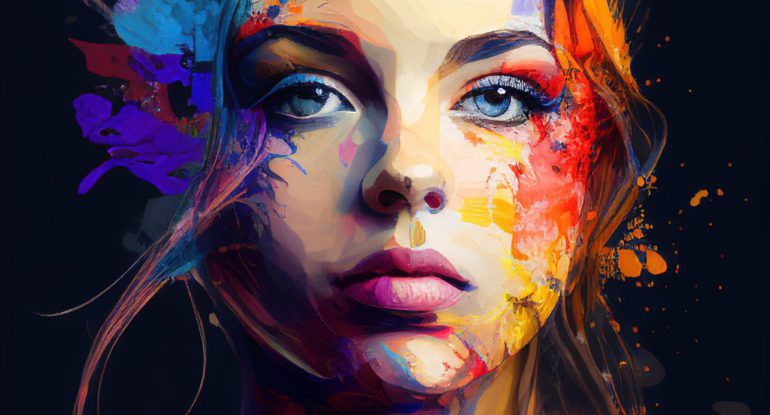The Rise Of NFTs: Top 10 NFT Artists Making Waves In the NFT Space

The NFT space is a rapidly growing sector within the blockchain and cryptocurrency industry. NFTs are unique digital assets that represent ownership or proof of authenticity of a specific item or piece of content, such as artwork, music, videos, virtual real estate, collectibles, and more. Unlike cryptocurrencies like Bitcoin or Ethereum, which are fungible and can be exchanged on a like-for-like basis, each NFT has distinct properties that make it one-of-a-kind.
One of the key features of NFTs is their ability to be easily verified and traced back to their original creators or owners. This is made possible through the use of blockchain technology, which serves as a decentralized and transparent ledger that records all transactions and ownership history. By utilizing blockchain, NFTs provide a high level of security, immutability, and scarcity, making them valuable digital assets.
The NFT market has gained significant attention and experienced explosive growth in recent years. One of the driving factors behind this growth is the increased interest from artists, musicians, and other content creators who see NFTs as a new way to monetize their work and connect with their audience directly. NFTs enable creators to sell their digital creations directly to collectors, eliminating the need for intermediaries such as galleries, agents, or publishers. This direct relationship between creators and consumers has the potential to revolutionize various creative industries.
Art has been one of the most prominent sectors within the NFT space. Artists can tokenize their artworks as NFTs, allowing them to retain the rights to their creations while selling ownership or limited editions to collectors. This has opened up new revenue streams for artists and has democratized the art market, enabling emerging artists to gain recognition and monetize their work more easily.
Apart from art, the NFT space has expanded into other areas as well. Sports collectibles have become increasingly popular, with professional athletes and sports leagues launching their own NFTs. These digital collectibles can include moments from games, player cards, virtual merchandise, and more. The appeal of owning a unique piece of sports history or memorabilia in digital form has attracted a large and passionate fan base.
Virtual real estate is another emerging sector within the NFT space. With the rise of virtual worlds and metaverses, such as Decentraland, The Sandbox, and Cryptovoxels, users can buy, sell, and trade virtual land and properties as NFTs. These virtual assets can be developed, customized, and monetized by their owners, creating a vibrant virtual economy.
Despite its rapid growth and potential, the NFT space also faces challenges and criticisms. One of the concerns raised is the environmental impact of NFTs, particularly due to the energy consumption associated with blockchain transactions. The majority of NFTs are currently based on the Ethereum blockchain, which uses a proof-of-work consensus mechanism. However, efforts are underway to develop more sustainable alternatives, such as the transition to the proof-of-stake consensus mechanism.
Additionally, there have been cases of fraud and plagiarism within the NFT space, where unauthorized copies or counterfeit NFTs have been sold. Ensuring the authenticity and provenance of NFTs is an ongoing challenge that the industry is actively addressing through improved verification mechanisms and standards.
In conclusion, the non-fungible token space represents a new frontier for digital ownership and creativity. It offers unique opportunities for artists, creators, and collectors to engage with digital assets in novel ways. While still a relatively nascent industry, the NFT space continues to evolve, with new use cases, technologies, and regulations shaping its future trajectory.
Also read: Top 10 Reasons Fashion Brands Are promoting NFTs
Importance of Non-Fungible Token for the Economy
Non-fungible tokens (NFTs) have gained significant importance in the economy due to their potential to revolutionize various industries and reshape traditional economic models. Here are several key aspects highlighting the importance of NFTs for the economy:
1. Creator Monetization: NFTs provide creators, such as artists, musicians, and content creators, with new avenues for monetizing their work. By tokenizing their creations as NFTs, creators can sell unique digital assets directly to collectors, eliminating the need for intermediaries. This direct relationship between creators and consumers enables artists to retain more control over their work and receive a larger share of the revenue generated from sales. It empowers creators who may have previously struggled to monetize their work through traditional channels, ultimately driving economic growth within the creative industry.
2. Digital Asset Ownership: NFTs establish verifiable ownership and provenance of digital assets. In the digital realm, where content can be easily copied and shared, NFTs enable the creation of scarce and unique digital items. This has tremendous implications for various industries, such as art, gaming, and collectibles, where the ownership and authenticity of digital assets are crucial. NFTs enable individuals to establish ownership of digital items and sell them on secondary markets, creating new economic opportunities.
3. Secondary Market Transactions: NFTs facilitate secondary market transactions, allowing owners of NFTs to sell or trade their assets with others. This vibrant secondary market creates liquidity and economic activity around digital assets. It opens up new possibilities for collectors and investors to participate in a growing market, driving demand and value for NFTs. The ability to buy and sell NFTs in a secure and transparent manner enables the development of digital asset marketplaces that operate 24/7 globally, providing economic opportunities and accessibility to a wider range of participants.
4. Intellectual Property Rights and Royalties: NFTs can embed smart contracts that automate the payment of royalties to creators whenever their NFTs are resold on secondary markets. This feature ensures that artists and content creators continue to benefit from the value appreciation of their work over time. The ability to receive ongoing royalties incentivizes creators, encourages innovation, and provides a sustainable income stream. It also helps establish clearer and more transparent intellectual property rights in the digital space, enhancing the overall economic value of creative works.
5. Virtual Economies and Metaverses: NFTs play a crucial role in the development of virtual economies and metaverses. Virtual worlds, such as Decentraland and Cryptovoxels, are built on blockchain technology and utilize NFTs as the foundation for virtual assets and properties. Users can buy, sell, and trade virtual land, buildings, and other digital assets as NFTs, creating a vibrant virtual economy. These virtual economies generate economic activity, entrepreneurship, and job opportunities within the metaverse, blurring the boundaries between the digital and physical economies.
6. Tokenization of Real-World Assets: NFTs also enable the tokenization of real-world assets, such as real estate, rare collectibles, and luxury goods. By representing physical assets as NFTs, these assets can be fractionalized, allowing multiple investors to own a share of an asset. This opens up new investment opportunities, improves liquidity for traditionally illiquid assets, and broadens access to asset classes that were previously restricted to a select few. The tokenization of real-world assets has the potential to reshape traditional financial markets and democratize investment opportunities.
Overall, the importance of NFTs for the economy lies in their ability to empower creators, establish digital asset ownership, create secondary markets, provide sustainable income streams, drive innovation, and enable the development of virtual economies. As the NFT space continues to evolve, it will likely have far-reaching implications across various industries, shaping the future of the global economy.
Also read: Top 10 NFT Artists Of 2023 Whoes Works You Need To Know
Top 10 Artists Making Waves in the NFT Space
The NFT space is constantly evolving, with new artists emerging all the time. Here are 10 artists who are making waves in the NFT space:
1. Pak
Pak is an anonymous digital artist who has been active in the crypto space for over two decades. Their work is often conceptual and thought-provoking, and they have sold some of the most expensive NFTs ever created. 
2. Beeple
Beeple, whose real name is Mike Winkelmann, is a digital artist who has been creating a daily artwork for over 13 years. In 2021, his NFT collection “Everydays: The First 5000 Days” sold for over $69 million at Christie’s auction house, making him one of the most successful NFT artists of all time.
3. FEWOCiOUS
FEWOCiOUS is a 19-year-old artist who has quickly become one of the most popular NFT artists in the world. Their work is often colorful and playful, and they have a strong following on social media.

4. XCOPY
XCOPY is a digital artist who is known for their dark and dystopian artworks. Their work often explores themes of death, decay, and artificial intelligence.
5. Dmitri Cherniak
Dmitri Cherniak is a software engineer and artist who is known for his minimalist NFT artworks. His work is often based on mathematical principles, and it has a strong following among collectors.

6. Hackatao
Hackatao is a duo of digital artists who are known for their colorful and playful artworks. Their work often features animals, robots, and other futuristic elements.
7. Fewocious
Fewocious is a 19-year-old artist who has quickly become one of the most popular NFT artists in the world. Their work is often colorful and playful, and they have a strong following on social media.
8. Trevor Jones
Trevor Jones is a digital artist who is known for his photorealistic NFT artworks. His work often features landscapes, animals, and other natural elements.
9. Snowfro
Snowfro is a digital artist who is known for their minimalist NFT artworks. Their work is often based on geometric shapes and patterns. 
10. Monica Rizzolli
Monica Rizzolli is a digital artist who is known for her generative NFT artworks. Her work often features abstract patterns and shapes. These are just a few of the many talented artists who are making waves in the NFT space. As the NFT market continues to grow, we can expect to see even more innovative and creative work from these artists in the years to come.
Benefits of NFT Space
The NFT space offers several key benefits that contribute to its growing popularity and potential impact on various industries. Here are some of the benefits of the NFT space:
1. Authenticity and Provenance: NFTs provide a robust solution for establishing authenticity and provenance of digital assets. Each NFT is uniquely identified and recorded on a blockchain, creating an immutable and transparent record of ownership and transaction history. This ensures that the ownership and origin of a digital asset can be easily verified, preventing counterfeiting and fraud. For artists, creators, and collectors, this level of transparency and trust is crucial in the digital realm where replication and unauthorized copying are common.
2. Creator Empowerment and Monetization: NFTs empower creators to directly monetize their work and retain more control over their intellectual property. By tokenizing their creations as NFTs, artists, musicians, and content creators can sell their work directly to their audience, bypassing traditional intermediaries such as galleries, publishers, or streaming platforms. This direct connection enables creators to establish their own pricing, distribution, and revenue-sharing models, leading to increased financial independence and potential for higher profits.
3. New Revenue Streams: NFTs unlock new revenue streams for creators by enabling them to earn ongoing royalties from secondary market sales. Smart contracts embedded within NFTs can automatically distribute a percentage of each subsequent sale back to the original creator. This feature provides creators with a sustainable income stream as their work gains value over time, incentivizing further creativity and innovation.
4. Digital Asset Ownership and Transferability: NFTs revolutionize digital asset ownership by providing a clear and transferable proof of ownership. In traditional digital environments, ownership of digital assets is often uncertain or limited to usage rights. NFTs, on the other hand, grant owners exclusive rights to a unique digital asset, including the ability to transfer or sell it. This introduces new possibilities for individuals to truly own and control their digital assets, from artwork and music to virtual real estate and in-game items.
5. Liquidity and Market Access: The NFT space has created a vibrant secondary market for trading and exchanging digital assets. NFT owners have the ability to sell their assets on specialized marketplaces, providing liquidity and allowing for price discovery. This enables collectors and investors to participate in the growing NFT market and benefit from its potential value appreciation. Additionally, the digitization of assets through NFTs improves accessibility, as individuals can easily buy, sell, and trade assets globally without geographic limitations.
6. Democratization of Creativity and Investment: NFTs have the potential to democratize creativity and investment opportunities. By removing barriers to entry and gatekeepers, NFTs allow emerging artists, musicians, and content creators to gain recognition, monetize their work, and connect directly with their audience. Similarly, the tokenization of assets through NFTs enables fractional ownership, making traditionally high-value assets accessible to a broader range of investors. This democratization encourages diversity, innovation, and economic inclusion in the creative and investment sectors.
7. Unique Experiences and Interactions: NFTs enable unique digital experiences and interactions for both creators and consumers. Through the use of smart contracts, NFTs can be programmed to unlock additional content, perks, or experiences for their owners. This could include VIP access to events, exclusive merchandise, or participation in virtual communities. These enhanced interactions and personalized experiences add value to NFT ownership and foster stronger connections between creators and their audience.
In conclusion, the benefits of the NFT space encompass authenticity, creator empowerment, new revenue streams, ownership rights, market liquidity, democratization, and unique experiences. As the NFT ecosystem continues to evolve, it has the potential to reshape industries, redefine value in the digital world, and unlock new economic opportunities for creators, investors, and consumers alike.
Also read: NFTs And Luxury Goods: How NFTs Can Be Used To Create Unique And Exclusive Luxury Goods
Future of Non-Fungible Token Space
The future of the NFT space is filled with immense potential and possibilities. As the technology and adoption continue to evolve, several key trends and developments can be expected:
1. Expansion into New Industries: While the NFT space has gained significant traction in art, gaming, and collectibles, we can expect its expansion into new industries. Industries such as fashion, music, film, real estate, and sports are likely to embrace NFTs as a means of creating unique digital experiences, establishing ownership rights, and engaging with their audience in innovative ways. NFTs could be used to tokenize virtual fashion items, sell digital rights to music or film content, enable fractional ownership of real estate, and offer digital collectibles associated with sports events.
2. Enhanced Interoperability and Standards: Currently, the NFT space is somewhat fragmented, with multiple blockchains hosting different NFT projects. In the future, we can expect increased interoperability and standardization efforts to create seamless cross-chain transactions and interactions. This will enable NFTs to move more freely across different platforms and ecosystems, increasing liquidity and market accessibility.
3. Sustainable and Energy-Efficient Solutions: Concerns about the environmental impact of NFTs, particularly due to the energy consumption of blockchain networks, have gained attention. To address these concerns, the industry is actively exploring and developing more sustainable and energy-efficient alternatives. This includes the adoption of proof-of-stake consensus mechanisms, which consume significantly less energy compared to the current dominant proof-of-work models. These advancements will help reduce the carbon footprint associated with NFTs and ensure the long-term viability of the technology.
4. Improved User Experience: As the NFT space matures, user experience (UX) will become increasingly important. User-friendly platforms and marketplaces that simplify the process of creating, buying, and selling NFTs will emerge. These platforms will focus on enhancing the overall UX, making it more accessible and intuitive for creators, collectors, and investors. Additionally, advancements in blockchain scalability and transaction speed will contribute to a smoother and more efficient user experience.
5. Integration of Augmented Reality (AR) and Virtual Reality (VR): The integration of NFTs with augmented reality (AR) and virtual reality (VR) technologies holds great potential. NFTs can be visualized and experienced in virtual environments, allowing users to interact with their digital assets in immersive ways. Virtual galleries, exhibitions, and metaverses will provide unique experiences for art, gaming, and entertainment, blurring the boundaries between physical and digital worlds.
6. Enhanced Intellectual Property Protection: The NFT space will likely witness advancements in intellectual property protection mechanisms. Solutions to prevent plagiarism, counterfeiting, and unauthorized use of digital assets will be developed, ensuring the authenticity and value of NFTs. Technologies such as digital watermarking, content recognition algorithms, and decentralized copyright registries may emerge to address these concerns and safeguard creators’ rights.
7. Integration with Decentralized Finance (DeFi): The integration of NFTs with decentralized finance (DeFi) protocols will enable new financial services and opportunities. NFT collateralization, lending, and trading platforms will emerge, allowing individuals to leverage their NFT holdings for loans, earn interest, or participate in decentralized marketplaces. This convergence of NFTs and DeFi will unlock liquidity, create novel financial instruments, and introduce additional utility to NFT ownership.
In conclusion, the future of the non-fungible token space is characterized by expanding into new industries, interoperability, sustainability, improved user experience, AR/VR integration, enhanced intellectual property protection, and integration with DeFi. As the technology and ecosystem continue to evolve, NFTs have the potential to transform multiple sectors, redefine ownership and value in the digital realm, and offer new economic opportunities for creators, investors, and consumers.
In case you were wondering if the inequity in the NFT space was an isolated thing for women in art: There are no women in the top 0.03% of the traditional auction market, where 41% of the profit is concentrated. Overall, 96% of artworks sold at auction are by male artists.
— BETTY (@betty_nft) January 23, 2022




























































